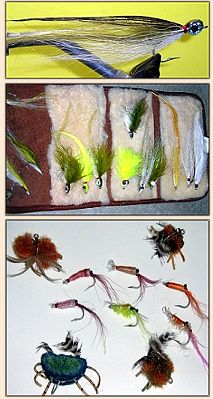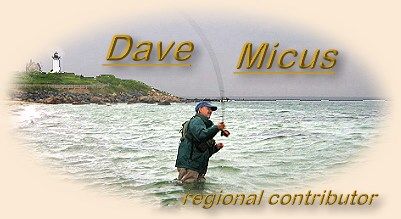|
It is almost time, and the way to describe
it best is that feeling you had as a child
when the end of the school year and beginning
of summer is only two weeks away. 'Only' is
a poor choice of words; it is certainly the
longest two weeks of your life. In two weeks
(or three or four, if the fish gods are cruel),
the striped bass will be returning to the shores
of Cape Ann.
They were last here in November, and, damn,
it's been a long time since I've felt the
throb of a fish on the line. I could have
fished for trout, or even bass, but I'm a
saltwater snob and usually don't even bother
to buy a freshwater license. In all of my
trouting trips I have never caught 40+ fish,
or spent the day catching trout over 24 inches,
but I've done that so often with striped bass
that I've lost count. That kind of fishing
can spoil a man.

And now, for the first time since I stowed it
all, I can begin the sacred ritual of preparing
the gear. The reels are taken from their cases,
the excess grease cleaned off, and new backing
added (which I always do myself after a fly shop
clerk trapped a loop which I, fortunately,
discovered while cleaning the line and not by
that rifle shot retort of a big fish snapping
the leader). Then the line, which was stored
on a line winder to lessen memory, is tied to
the backing with an Albright and wound on, and
last years loops are cut off and new ones tied
before adding the nine foot twenty pound test
fluro leader with the bimini twist. The clear
intermediate, my favorite, is wound on the Penn
International; the Spey, longer than standard
fly line, is wound on the 9/10 Redington RS2,
a large arbor reel that runs a little big. The
floating and sink tip are wound on the 7/8
Redington RS2's, and I make a mental note to
keep an eye on all the RS2 reels, as, in an
unacceptable oversight, the spool release lever
is not stainless steel nor anodized, and it is
prone to rust (which can run down the spindle
and into the drag). I've contacted Redington
about this problem and received no response,
which is not the kind of service that I've come
to expect, and I wish they were still an
independent company owned by Jim Murphy.
Next I break out the rods-the 12.5 foot two
hander for early season shore fishing; the
10 foot eight weight for fishing from the
kayak, and, my favorite, a 9 foot nine weight
diamondback that I won in a raffle, an
inexpensive rod that's very stiff but suits
my casting style quite well, particularly
when double hauling. (If you have a problem
with tailing loops when you haul, try a stiffer
rod.)

Then it's on to fly tying. I don't tie many
flies, usually just a few clouser variations,
some thundercreek style flatwings (a favorite
fly of my own design), a few Ray's flies and
some gurglers, and a few shrimp and crab patterns
that I'll never get around to fishing. I'll
tie up a couple of clam worms just in case I
hit the worm hatch during June's full moon when
the bass won't eat anything else. I never carry
more than a dozen or so flies, replenishing the
wallet as necessary before each outing (I have
more confidence in newly tied flies). And this
year I can't wait to try some different flies.
A Canadian friend, Christopher Wojda, has sent
me some dremel bugs, flies almost to beautiful
to fish, to try in the salt. I know the striped
bass are going to love them.

Lastly it's a quick check of the gear; make
certain the zippers on the chest pack are lubed,
put the waterproof binoculars and flashlight in
one pocket, the tippet and lead tips in another,
put the fly wallet in the pocket most accessible,
hook the nippers to the zinger and clip the
hemostats onto the back of the pack where it is
out of the way of errant fly line but within easy
reach for freeing a deeply hooked fish. The chest
pack and the waders are hung by the door, over
the wading boots and flats booties.
The final ceremony is to string up a rod, complete
with fly. It is kept by the basement door so that
it is ready to fish when the bass are spotted in
front of the house, a common enough occurrence that
my kids no longer think the house is on fire when
they see me flying down the stairs and out the door.

With that all done, I'll begin scanning the
water with the binoculars that are always
kept on the living room windowsill. This
early in the season it is just practice
(though I did see gulls feeding the other
day), but in just a short time I'll see bass
busting, and I'll become convinced that by
looking long and hard enough I can will them
to feed, which, inexplicably, often seems to
work. Then it will be a mad dash through the
house, grabbing the rod always kept strung up
by the basement door, and out to the water.
Only two more weeks. ~ Dave
About Dave:
 Dave Micus lives in Ipswich, Massachusetts. He is an
avid striped bass fly fisherman, writer and instructor.
He writes a fly fishing column for the Port City Planet
newspaper of Newburyport, MA (home of Plum Island and Joppa Flats)
and teaches a fly fishing course at Boston University.
Dave Micus lives in Ipswich, Massachusetts. He is an
avid striped bass fly fisherman, writer and instructor.
He writes a fly fishing column for the Port City Planet
newspaper of Newburyport, MA (home of Plum Island and Joppa Flats)
and teaches a fly fishing course at Boston University.
|









